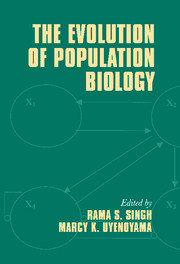Book contents
- Frontmatter
- Contents
- List of contributors
- Publications of R. C. Lewontin
- Preface
- Introduction
- Part I Historical foundations and perspectives
- Part II Genotypes to phenotypes: new genetic and bioinformatic advances
- 3 Genetic dissection of quantitative traits
- 4 Gene expression profiling in evolutionary genetics
- 5 Population biology and bioinformatics
- 6 Beyond beanbag genetics: Wright's adaptive landscape, gene interaction networks, and the evolution of new genetic systems
- Part III Phenotypes to fitness: genetics and ecology of populations
- Part IV Genes, organisms, and environment: evolutionary case studies
- Part V Applied population biology: biodiversity and food, disease, and health
- Index
3 - Genetic dissection of quantitative traits
Published online by Cambridge University Press: 08 January 2010
- Frontmatter
- Contents
- List of contributors
- Publications of R. C. Lewontin
- Preface
- Introduction
- Part I Historical foundations and perspectives
- Part II Genotypes to phenotypes: new genetic and bioinformatic advances
- 3 Genetic dissection of quantitative traits
- 4 Gene expression profiling in evolutionary genetics
- 5 Population biology and bioinformatics
- 6 Beyond beanbag genetics: Wright's adaptive landscape, gene interaction networks, and the evolution of new genetic systems
- Part III Phenotypes to fitness: genetics and ecology of populations
- Part IV Genes, organisms, and environment: evolutionary case studies
- Part V Applied population biology: biodiversity and food, disease, and health
- Index
Summary
It is clear that descriptions of the genetic variation in populations are the fundamental observations on which evolutionary theory depends. Such observations must be both dynamically and empirically sufficient if they are to provide the basis for evolutionary explanations and predictions. … (W)e see that a sufficient description of variation is necessarily a description of the statistical distribution of genotypes in a population, together with the phenotypic manifestation of those genotypes over the range of environments encountered by the population. The description must be genotypic because the underlying dynamical theory of evolution is based on Mendelian genetics. But the description must also specify the relations between genotype and phenotype, partly because it is the phenotype that determines the breeding system and the action of natural selection, but also because it is the evolution of the phenotype that interests us. Population geneticists, in their enthusiasm to deal with the changes in genotype frequencies that underlie evolutionary changes, have often forgotten that what are ultimately to be explained are the myriad and subtle changes in size, shape, behavior, and interactions with other species that constitute the real stuff of evolution.
(Lewontin 1974, p. 19)Evolutionarily significant genetic variation is then, almost by definition, variation that is manifest in subtle differences between individuals, often so subtle as to be completely overwhelmed by effects of other genes or of the environment … We see here the fundamental contradiction inherent in the study of the genetics of evolution. […]
- Type
- Chapter
- Information
- The Evolution of Population Biology , pp. 51 - 73Publisher: Cambridge University PressPrint publication year: 2004
- 4
- Cited by

